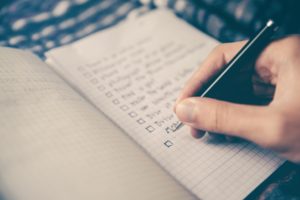Where do I begin? This seems to be a common question asked when someone realizes they are not as well prepared to protect themselves and their family in an emergency situation as they should be. That’s exactly what prompted me to ask this question recently.

Making a list – writing down your plan
After researching this topic, and based on my personal experience as a project manager, I think the answer to how to start prepping is a fairly simple one – start by making a plan. Sit down and do a risk evaluation to determine what emergency situations are most likely to occur based on where you live and your personal situation.
Then, based on this evaluation, start considering what you need to do, get, or learn to be prepared for these situations. Prioritize these and then start doing, getting, and/or learning what you need.
Find Planning Resources
Although I’m very familiar with risk assessment and planning, I thought it would be helpful to have a guide in starting out with because I’d never really done this kind of evaluation before. There are a lot of resources out there, including books, videos, websites, and countless others. So after evaluating some of these choices, I decided to start with this site:
https://www.redcross.org/get-help/how-to-prepare-for-emergencies/make-a-plan.html
At the top of the page there is a simple three step process, and there is a template you can download to fill in the information about the plans you devise. If you read through the entire page, you will see links to a variety of resources, including their specific disaster information page here:
https://www.redcross.org/get-help/how-to-prepare-for-emergencies/types-of-emergencies.html
Overall, it seems to me to be a very thorough resource for getting started in creating your plans and preparations. Then you just have to put these in place so that you are ready when an emergency happens. I recommend getting started right away.
One more resource from that site is the page showing common disasters across the US by region, which can be found here:
The map separates out seven regions (including US territories) and provides information about the most common natural disasters in those regions. Since you live there, you’ll likely have some idea about what these are, but when planning it can be helpful to have a list in front of you to help prevent forgetting about something that comes back to bite you later.
Practice, Practice, Practice
Don’t neglect the third step. Practice may feel weird, and it may even be difficult to figure out how you can practice for some things, but start with what you can.
Have a fire drill and make sure everyone shows up to the designated spot. Then, after a few times change the scenario so that everyone has to go to your alternate spot and see how they do. If you live somewhere that is prone to tornadoes, have a drill grabbing what you need and going to your designated safe space.
Even table-top practice could help. This is where you all sit at a table and just verbally walk through the plan. For a fire drill you might set up the scenario that the primary exit is blocked by fire, then ask everyone to tell you what they are supposed to do.
This can help ensure no one has to think too hard about what to do in the middle of a real emergency. It may seem like it is easy to figure out on the fly, but when adrenaline starts pumping your logical thinking gets diminished and you’re bound to make mistakes, especially if you’ve never actually done it before.
Also, running practice drills will help you uncover gaps in your plan. Maybe you can’t fit everyone into the safe space – not something you want to find out when there is a tornado bearing down.